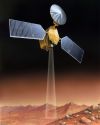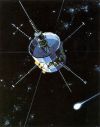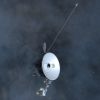Emily Lakdawalla • Feb 01, 2010
What's up in the solar system in February 2010
Probably the biggest topic of discussion this month will concern the news contained within the President's proposed fiscal year 2011 budget, about which there was a NASA press conference this morning. Lou Friedman commented in the blog on this topic -- I encourage you to read and comment on what he has to say. Also, there will be two launches this month, of the Space Shuttle Endeavour on the STS-130 mission to the space station (currently planned for February 7) and the Solar Dynamics Observatory (currently February 9). So now let's explore what's going on with our active spacecraft.
In the inner solar system:
 The MESSENGER spacecraft is cruising along. Mercury orbit insertion is planned for March 18, 2011.
The MESSENGER spacecraft is cruising along. Mercury orbit insertion is planned for March 18, 2011.
 Venus Express remains healthy (as of November 14) in orbit at Venus. Its current mission extension runs through 2012.
Venus Express remains healthy (as of November 14) in orbit at Venus. Its current mission extension runs through 2012.
 Lunar Reconnaissance Orbiter is busily mapping the Moon from its science orbit. The Lunar Recon Orbiter Camera team just announced their second "prerelease" of data to the Planetary Data System. Of their recent captioned image releases, my favorite is this one of the crazily bumpy Tycho crater floor. Many of LROC's recent images are targeted at "Constellation regions of interest." With Constellation canceled, I'm sure LROC is continuing the science as planned -- for now -- but I wonder how things are going to shift in the future. There is also this really cool Digital Terrain Model of the Orientale multi-ring basin, which was developed from analysis of LROC wide-angle camera images using software systems that were originally developed for Mars Express' High Resolution Stereo Camera.
Lunar Reconnaissance Orbiter is busily mapping the Moon from its science orbit. The Lunar Recon Orbiter Camera team just announced their second "prerelease" of data to the Planetary Data System. Of their recent captioned image releases, my favorite is this one of the crazily bumpy Tycho crater floor. Many of LROC's recent images are targeted at "Constellation regions of interest." With Constellation canceled, I'm sure LROC is continuing the science as planned -- for now -- but I wonder how things are going to shift in the future. There is also this really cool Digital Terrain Model of the Orientale multi-ring basin, which was developed from analysis of LROC wide-angle camera images using software systems that were originally developed for Mars Express' High Resolution Stereo Camera.
At the Sun:
 Images from the ESA/NASA SOHO mission show a single sunspot that is part of the new solar cycle 24. As always, SOHO's near-real-time data and images are available here.
Images from the ESA/NASA SOHO mission show a single sunspot that is part of the new solar cycle 24. As always, SOHO's near-real-time data and images are available here.
 The twin STEREO spacecraft now provide nearly full longitude coverage on the Sun, as STEREO-A is 65 degrees ahead of Earth and STEREO-B is 70 degrees behind. That leaves only about 45 degrees of longitude not visible from any spacecraft.. The daily STEREO image viewer shows three big sunspots on the far side of the Sun from Earth.
The twin STEREO spacecraft now provide nearly full longitude coverage on the Sun, as STEREO-A is 65 degrees ahead of Earth and STEREO-B is 70 degrees behind. That leaves only about 45 degrees of longitude not visible from any spacecraft.. The daily STEREO image viewer shows three big sunspots on the far side of the Sun from Earth.
On to Mars:
 Out at Mars, it's mid southern hemisphere autumn (Ls 46°). Today it is Mars Exploration Rover Spirit sol 2162 and Opportunity sol 2142. As I mentioned in my writeup last week, NASA has directed the mission to quit trying to extricate Spirit, but the rover's wheels are still rolling as they try to tilt the solar panels more toward the north ahead of the coming winter. The name of Spirit's game for the next year or so will be just surviving the winter. Opportunity has now reached a very fresh-looking crater (see my posts on that here and here) and is pausing to take a color panorama and (no doubt) to do some other science before continuing on her drive toward Endeavour. A. J. S. Rayl 's latest rover update is here. And today's Planetary Radio features John Callas, the rovers' project manager.
Out at Mars, it's mid southern hemisphere autumn (Ls 46°). Today it is Mars Exploration Rover Spirit sol 2162 and Opportunity sol 2142. As I mentioned in my writeup last week, NASA has directed the mission to quit trying to extricate Spirit, but the rover's wheels are still rolling as they try to tilt the solar panels more toward the north ahead of the coming winter. The name of Spirit's game for the next year or so will be just surviving the winter. Opportunity has now reached a very fresh-looking crater (see my posts on that here and here) and is pausing to take a color panorama and (no doubt) to do some other science before continuing on her drive toward Endeavour. A. J. S. Rayl 's latest rover update is here. And today's Planetary Radio features John Callas, the rovers' project manager.
 Mars Reconnaissance Orbiter is humming along in normal science operations. The latest MARCI weather report indicates mild weather across most of Mars, and water ice clouds forming here and there. The latest captioned image releases from HiRISE include the usual sort of spectacularness. I am particularly fond of HiRISE's views of megabreccias.
Mars Reconnaissance Orbiter is humming along in normal science operations. The latest MARCI weather report indicates mild weather across most of Mars, and water ice clouds forming here and there. The latest captioned image releases from HiRISE include the usual sort of spectacularness. I am particularly fond of HiRISE's views of megabreccias.
 ESA's Mars Express is still diligently mapping Mars. ESA announced last week that Mars Express is gearing up for a triplet of very close Phobos flybys. The closest, on March 3 at 20:55 UTC, will come within 50 kilometers of the moon. That flyby will be used for radio science -- mapping Phobos' gravity field, useful information for studying its internal structure. The two flybys that bracket the closest flyby will be used for "other scientific investigations including radar sounding and imaging," according to the ESA announcement. The Mars Webcam is currently returning mostly high-phase shots of Mars, but there have been some really cool lower-altitude sequences where Mars totally fills the frame. For the next few months, VMC images will be downlinked more rapidly than normal, meaning that in some cases, VMC images appear on the Web within hours of their capture on the spacecraft! You can learn more about how to process VMC images using this tutorial.
ESA's Mars Express is still diligently mapping Mars. ESA announced last week that Mars Express is gearing up for a triplet of very close Phobos flybys. The closest, on March 3 at 20:55 UTC, will come within 50 kilometers of the moon. That flyby will be used for radio science -- mapping Phobos' gravity field, useful information for studying its internal structure. The two flybys that bracket the closest flyby will be used for "other scientific investigations including radar sounding and imaging," according to the ESA announcement. The Mars Webcam is currently returning mostly high-phase shots of Mars, but there have been some really cool lower-altitude sequences where Mars totally fills the frame. For the next few months, VMC images will be downlinked more rapidly than normal, meaning that in some cases, VMC images appear on the Web within hours of their capture on the spacecraft! You can learn more about how to process VMC images using this tutorial.
 NASA's Mars Odyssey remains the longest-lived spacecraft in orbit at Mars. You can see the latest from its THEMIS instrument here. Here is a cool photo of a bunch of yardangs, steamlined features eroded by wind, and a really beautiful set of lava-eroded channels called Hephaestus Fossae.
NASA's Mars Odyssey remains the longest-lived spacecraft in orbit at Mars. You can see the latest from its THEMIS instrument here. Here is a cool photo of a bunch of yardangs, steamlined features eroded by wind, and a really beautiful set of lava-eroded channels called Hephaestus Fossae.
Exploring Saturn:
 Cassini is in the last few months of its extended mission, the "Equinox Mission." Now that the NASA budget announcement is out of the way, we will hopefully hear soon that the mission has been extended again, this time for a further seven years, in the "Solstice Mission" or "XXM" (extended-extended mission). Cassini's back in Saturn's ring plane again, so there will be numerous opportunities this month for decent observations of the moons, both singly and as they transit each other. Cassini's rev 126 starts on February 4, and rev 127 on February 22; both orbits have periods of 17.5 days, which is interesting, because it is difficult to see how that period relates to Titan's 16-day orbit. That means Cassini will actually not get very close to Titan again for a while -- according to my Cassini tour page, the next targeted Titan flyby (and hence the next opportunity to accomplish a change to Cassini's orbit) is not until April 5! In between now and then, there will be very close, targeted flybys of Rhea (at 100 kilometers altitude) and Dione's leading co-orbital moon Helene (at 1803 kilometers) on March 2 and 3 -- clearly, this is the reason for the planned hiatus in Titan encounters.
Cassini is in the last few months of its extended mission, the "Equinox Mission." Now that the NASA budget announcement is out of the way, we will hopefully hear soon that the mission has been extended again, this time for a further seven years, in the "Solstice Mission" or "XXM" (extended-extended mission). Cassini's back in Saturn's ring plane again, so there will be numerous opportunities this month for decent observations of the moons, both singly and as they transit each other. Cassini's rev 126 starts on February 4, and rev 127 on February 22; both orbits have periods of 17.5 days, which is interesting, because it is difficult to see how that period relates to Titan's 16-day orbit. That means Cassini will actually not get very close to Titan again for a while -- according to my Cassini tour page, the next targeted Titan flyby (and hence the next opportunity to accomplish a change to Cassini's orbit) is not until April 5! In between now and then, there will be very close, targeted flybys of Rhea (at 100 kilometers altitude) and Dione's leading co-orbital moon Helene (at 1803 kilometers) on March 2 and 3 -- clearly, this is the reason for the planned hiatus in Titan encounters.
Quietly cruising:
 ESA's Rosetta is cruising along toward its May 2014 rendezvous with comet Churyumov-Gerasimenko. Via Twitterlast week, ESA mentioned that Rosetta will actually be going into a deep hibernation mode for several years beginning in 2011. Since these Tweets will get buried before long, I'll include their text here:
ESA's Rosetta is cruising along toward its May 2014 rendezvous with comet Churyumov-Gerasimenko. Via Twitterlast week, ESA mentioned that Rosetta will actually be going into a deep hibernation mode for several years beginning in 2011. Since these Tweets will get buried before long, I'll include their text here:
ESA's Rosetta began hibernation mode test 21.01 Excellent support from NASA DSN & ESA DSA networks. During this week's hibernation test, Rosetta was spun up for stability when attitude control system was turned OFF. Rosetta normally needs ~500W power. 2011-2014: distance from Sun means only 440W available - hence hibernation needed.
 The International Cometary Explorer remains on course for a return visit to Earth in 2014. When it does, ICE can be returned to a Sun-Earth L1 halo orbit, or can use multiple Earth swingbys to encounter Comet Wirtanen during its near-Earth apparition in December 2018.
The International Cometary Explorer remains on course for a return visit to Earth in 2014. When it does, ICE can be returned to a Sun-Earth L1 halo orbit, or can use multiple Earth swingbys to encounter Comet Wirtanen during its near-Earth apparition in December 2018.
![]() NASA's Dawn is now in the asteroid belt for good, and is steadily thrusting with its ion engines, patiently propelling itself toward a rendezvous with Vesta in July 2011. The latest Dawn Journal will be posted tomorrow.
NASA's Dawn is now in the asteroid belt for good, and is steadily thrusting with its ion engines, patiently propelling itself toward a rendezvous with Vesta in July 2011. The latest Dawn Journal will be posted tomorrow.
 NASA's Deep Impact is cruising toward its November flyby of comet 103P/Hartley 2.
NASA's Deep Impact is cruising toward its November flyby of comet 103P/Hartley 2.
 Last month NASA's Stardust celebrated 4000 days in space! It is cruising ever onward toward a February 14, 2011 encounter with comet Tempel 1. The January status reports indicate the spacecraft is in good health.
Last month NASA's Stardust celebrated 4000 days in space! It is cruising ever onward toward a February 14, 2011 encounter with comet Tempel 1. The January status reports indicate the spacecraft is in good health.
 As I reported recently, Hayabusa is still on track to return to Earth later this year; the latest status report indicates all is well, and that the steady thrusting of the ion engines has brought Hayabusa's predicted Earth close-approach point to under a million kilometers. (That is, if the engines were to die today, Hayabusa would sail past Earth at a distance of a million kilometers, about 2.5 times the Earth-Moon distance). Every day that the ion engines continue thrusting, this distance decreases. At present Hayabusa's actual distance from Earth is just under 46 million kilometers. This report indicates that they require a little under two more months of ion propulsion to achieve the trajectory they need to accomplish the sample return.
As I reported recently, Hayabusa is still on track to return to Earth later this year; the latest status report indicates all is well, and that the steady thrusting of the ion engines has brought Hayabusa's predicted Earth close-approach point to under a million kilometers. (That is, if the engines were to die today, Hayabusa would sail past Earth at a distance of a million kilometers, about 2.5 times the Earth-Moon distance). Every day that the ion engines continue thrusting, this distance decreases. At present Hayabusa's actual distance from Earth is just under 46 million kilometers. This report indicates that they require a little under two more months of ion propulsion to achieve the trajectory they need to accomplish the sample return.
 NASA's New Horizons has 16.12 AU to go to reach Pluto. It's still on course for a January to July 2015 encounter with the Pluto and Charon system. The spacecraft is presently in the middle of a long hibernation period with only weekly beacon and monthly telemetry reports until it wakes up again in May.
NASA's New Horizons has 16.12 AU to go to reach Pluto. It's still on course for a January to July 2015 encounter with the Pluto and Charon system. The spacecraft is presently in the middle of a long hibernation period with only weekly beacon and monthly telemetry reports until it wakes up again in May.
And beyond:
 Finally, NASA's Voyager 1 and 2 spacecraft were still responding to commands from Earth as of December 25. Both have now crossed the "termination shock," where the solar wind slows down as it impinges upon the interstellar medium.
Finally, NASA's Voyager 1 and 2 spacecraft were still responding to commands from Earth as of December 25. Both have now crossed the "termination shock," where the solar wind slows down as it impinges upon the interstellar medium.
Some other milestones to take note of this month, taken mostly from JPL's Space Calendar:
- February 14 will be the 20th anniversary of the Voyager Family Portrait.
- From February 18-20 there will be a Next-Generation Suborbital Researchers Conference, to which I'll be giving a remote presentation on amateur involvement in space missions.
The Time is Now.
As a Planetary Defender, you’re part of our mission to decrease the risk of Earth being hit by an asteroid or comet.
Donate Today

 Explore Worlds
Explore Worlds Find Life
Find Life Defend Earth
Defend Earth

